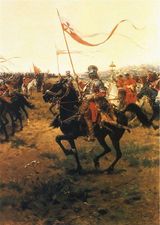Hall of Fame and Remembrance: Różnice pomiędzy wersjami
| Linia 12: | Linia 12: | ||
In 1776, the duties and traditions of the Hussar's were passed on to the '''[http://en.wikipedia.org/wiki/Uhlans Uhlans]''' by a parliamentary decree. | In 1776, the duties and traditions of the Hussar's were passed on to the '''[http://en.wikipedia.org/wiki/Uhlans Uhlans]''' by a parliamentary decree. | ||
| − | |||
* '''[http://www.youtube.com/watch?v=AyJdeSslnys&feature=channel&list=UL Film]''' | * '''[http://www.youtube.com/watch?v=AyJdeSslnys&feature=channel&list=UL Film]''' | ||
Wersja z 22:34, 26 paź 2012
There are many to remember and there are many of Ostoja's that served Poland in exceptional way. Each Ostoja family have their own heroes, here below are those that we all should remember as they represent all the Clan of Ostoja was in the past and will be in the future.
Husaria
"Heavy hussars of the Polish-Lithuanian Commonwealth" - Pride of Poland and the Commonwealth, the husaria banners or companies were considered the elite of the Polish-Lithuanian Commonwealth cavalry. They were widely regarded as the most powerful cavalry formation in the world. Polish Hussars were undefeated in battle for over 100 years often against forces sometimes 5 times bigger. Ostoja's participated in all those battles and also saved Vienna from the Ottoman's in 1683. In many cases, Ostoja's where the commanders of elite Hussar unites being Rittmeister's, which was the most honorable and respected position in Polish-Lithuanian army in the history.
In the battles of Lubiszew in 1577, Byczyna (1588), Kokenhausen (1601), Kircholm (1605), Kłuszyn (1610), Chocim (1621), Martynów (1624), Trzciana (1629), Ochmatów (1644), Beresteczko (1651), Połonka (1660), Cudnów (1660), Chocim (1673), and Lwów (1675), Vienna (1683), Párkány (1683) the Polish-Lithuanian hussars proved to be the decisive factor often against overwhelming odds. For instance, in the Battle of Kluszyn during the Polish-Muscovite War the Russians outnumbered the Commonwealth army 5 to 1, yet were heavily defeated.
The Hussar banner's was elite force of the nobility of the Commomwelath and the place in those formations was almost always reserved to the nobility. However, in Battle of Vienna, several persons of non-noble origin where admitted to join the force as they where professionally trained for this kind of mission. To serve in Husaria was therefore also a way to receive nobility.
In 1776, the duties and traditions of the Hussar's were passed on to the Uhlans by a parliamentary decree.
Stanisław Błociszewski (1804-1888)
Major of Polish Uprising army - participated in November Uprising and in Great Poland Uprising. Received the Gold Cross of Virtuti Militari. All three son's of Błociszewski took part in the January Uprising year 1863. Read more - Czytaj więcej
Bronisław Bohatyrewicz (1870–1940)
Military commander and a general of the Polish Army. Murdered in Katyn. Bohatyrewicz was one of the two Generals whose bodies were identified during the 1943 exhumation. Read more - Czytaj więcej
